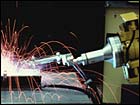|
Factory orders edge higher
|
 |
February 5, 2002: 3:50 p.m. ET
December orders edge up 1.2%, matching forecast; January services index dips.
|
NEW YORK (CNN/Money) - Orders for goods made in U.S. factories rose for the second time in three months in December at the end of an otherwise weak year, the government said Tuesday, the latest sign that the long-suffering manufacturing sector may be stabilizing.
Factory orders rose 1.2 percent in December to a seasonally adjusted $322.2 billion after a revised 4.3 percent drop in November, the Commerce Department reported. The rise matched forecasts of economists surveyed by Briefing.com.
While December's reading was boosted mainly by strong orders for transportation equipment, it was at least a sign of stabilization for manufacturing, which has been in a recession even longer than the broad economy, thanks to the bursting of a capital-spending bubble at the end of the 1990s.
"Factory orders point to an improved outlook for capital spending," Salomon Smith Barney economist Melanie Jani said.
Separately, the nation's corporate purchasing managers said a key index of service-sector activity dipped to 49.6 in January, slightly weaker than economists' forecasts, from 50.1 in December. A reading below 50 indicates contraction in services, while one above that points to growth.
In its report, the Institute of Supply Management, formerly known as the National Association of Purchasing Management, said its index of new orders fell in January while its employment index barely edged higher. The group's members buy goods and services for about 350 of the biggest American corporations.
The ISM also reports on activity in the manufacturing sector; its most recent report, released Friday, showed manufacturing continued to shrink in January, though at a slower pace.
Factories had a rough year despite the recent uptick in orders. Orders tumbled 8.5 percent for all of last year, the biggest decline since the Commerce Department began its current record-keeping in 1992.
In December, orders for transportation equipment jumped 3.6 percent, boosted by orders for missiles, space vehicles and parts. Computers and electronics equipment surged 3.1 percent.
To help set the stage for a recovery from a recession that some economists think began in March 2001, the Federal Reserve cut its target for short-term interest rates 11 times in 2001. It elected to leave rates alone in January, and recent economic data have led many U.S. economists to believe the recession is over.
Especially encouraging for the Fed and economists, manufacturers seem to be working off their backlog of unsold goods left over from the spending boom. Factory inventories fell 0.6 percent in December after falling 1.3 percent in November, according to the Commerce Department report.
Once inventories are reduced and demand picks up, production also can expand and more workers can be hired, possibly offering some relief to a labor market that lost more than a million jobs in 2001. 
|
|
|
|
|
|

|

